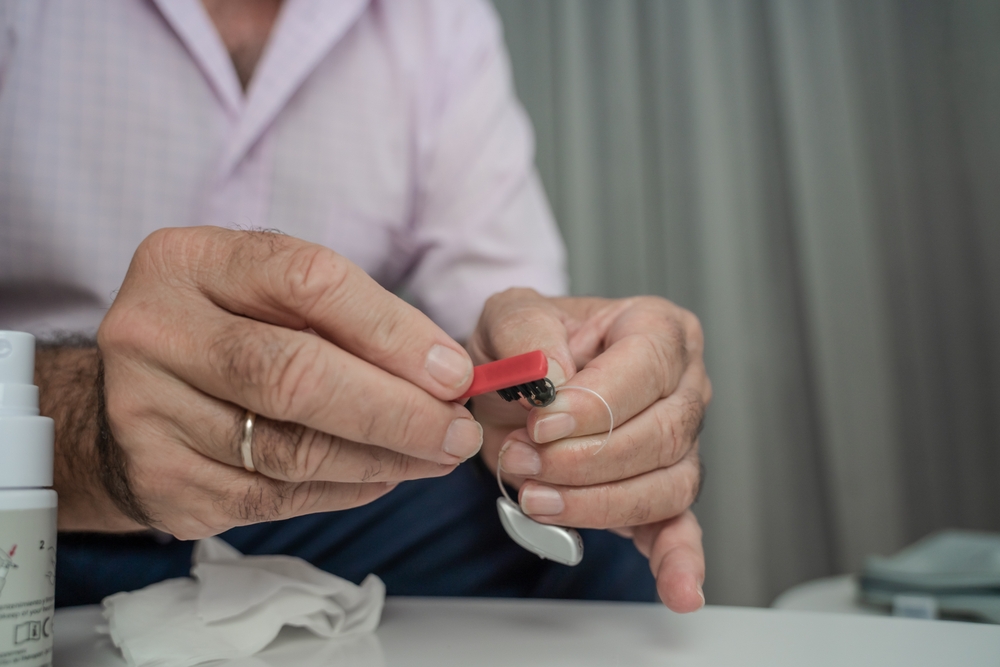
Once you’ve adjusted to life with your hearing aid, it becomes an important part of your daily routine. The likelihood of a breakdown can be unsettling, as it poses not only a disturbance to daily life, but also a substantial financial burden in the form of repair or replacement costs.
How to best maintain your hearing aid
Comprehending what can damage your hearing aid and learning how to care for it effectively will help you maintain its functionality and ensure it continues to enhance your quality of life.
Effective upkeep of batteries
Your hearing aid’s performance is highly dependent on its battery. Therefore, choosing the correct batteries for your hearing aid is crucial. Consult with your audiologist to find out which battery type is most suitable for your specific hearing aid model.
Handling the batteries with care is equally important. Oils, dirt, and moisture from your hands can contaminate the batteries, resulting in potential damage.
Always wash your hands before swapping out the battery, and make sure they are completely dried to prevent introducing moisture into the device.
Adhere closely to the manufacturer’s instructions, particularly pertaining to battery upkeep. To increase the battery life of your hearing aid, be certain to power it down when not using it and keep it stored in a safe , dry spot. Knowing the typical lifespan of a battery can also be quite helpful.
Make a note on your calendar every time you change the battery, so you can predict when it will need changing again. To avoid being stuck without power, always carry a spare battery with you, especially when you’re away from home.
Guard against moisture
As electronic devices, hearing aids are susceptible to moisture. Even brief contact can cause harm or complete failure of the device. Safeguard your hearing aid’s performance by purchasing a specialized drying device to maintain its functionality by removing moisture. This unit supplies a safe and dry atmosphere for your hearing aid when not in use, safeguarding it from damage related to unwanted moisture.
To protect your hearing aid from water damage, it’s a smart plan to take it out before taking part in activities that make you sweat heavily. Consult taking off your hearing aid to workout, particularly outdoors, with your hearing specialist, as doing so may jeopardize your safety by decreasing your recognition of important auditory cues, such as traffic noises or warning alarms. If possible, opt to work out inside where it is safer to remove your hearing aid, and make sure to remove your device before showering or swimming.
Additionally, avoid using hairspray, spray deodorants, and other aerosol products while using your hearing aid. These products consist of moisture and chemicals that can build up on the device, leading to long-term damage. Use these products before putting on your hearing aid to minimize exposure.
Control earwax buildup
While earwax serves as a natural shield, protecting your ears from debris, dirt, and tiny insects, it can also hamper the effective performance of your hearing aid. The buildup of earwax in the device can result in it not functioning properly. For correct maintenance, schedule an appointment with your audiologist or doctor to assess the amount of earwax accumulation and establish a personalized cleaning plan tailored to your ears and hearing device.
It is important to clean your ears carefully and never put anything foreign into your ear canal. As opposed to that, let warm water enter your ears while you are showering. This can help in losening up and eliminating some of the earwax. Routine professional ear cleaning is also advisable. Though this might be a bit of a hassle, it’s a trivial issue in comparison to the frustration and complications that can occur from a hearing aid that’s not functioning effectively due to a buildup of earwax.
When it comes to cleaning your hearing aid, follow the manufacturer’s instructions carefully.
Different types of hearing aids may require different cleaning techniques, and using the wrong method could cause harm to your device. If you’re unsure about the proper cleaning method, consult your hearing specialist or hearing aid provider to ensure you’re taking the correct steps to protect your device from earwax damage.
Easy methods to ensure lasting reliability
Once you get used to wearing your hearing aids, they become a critical aspect of your daily routine, making it hard to picture life without them. By using a few easy precautions, you can prevent damage and ensure your hearing aids remain dependable for years to come. Routine upkeep, appropriate storage, and cautious handling are essential to keeping your hearing aids in optimal condition, allowing you to keep enjoying the improved quality of life they supply.
If you are having problems with your hearing aid or need to schedule a routine maintenance appointment, please arrange for a visit.